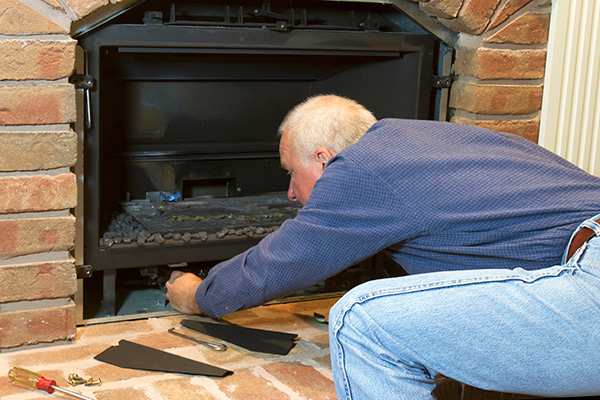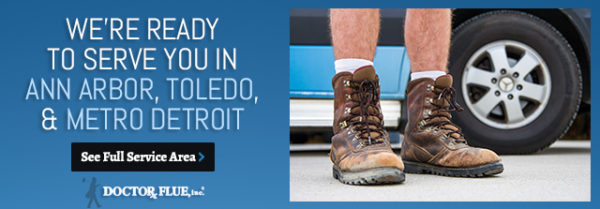The off-season is a great time to plan your chimney inspection. Especially for frequent fireplace users, you’ll keep your chimney well-maintained so you can enjoy it right away when the frigid weather comes around again. You may be surprised to discover that not all chimney inspections are the same. Depending on the circumstances, your chimney sweep may recommend one of three different chimney inspection levels to keep your home safe. Below, we’ll teach you about the distinct levels and what they mean for your home.

Chimney Inspection Level 1
Chimney inspections are categorized based on three levels, and it starts with level one. To perform this inspection, your chimney sweep will need only basic access to your chimney without the need of specialized tools. As the most routine of inspections, a level one is an inexpensive option to ensure your fireplace is safe to use when the temperature begins to drop.
When you take diligent care of your fireplace and schedule regular inspections, you’ll be more likely not to need escalated inspections. Among the other safety benefits of frequent inspections, this often means it’s more cost effective to plan these service visits than to wait for evidence of a problem.
During a level one inspection, the chimney sweep inspects easily-accessible portions of your chimney interior and exterior. They won’t need to use specialized tools, and often need at most just a screwdriver. The goal is to check the basic condition of your flue, which will identify common safety risks like combustible deposits that built up and need removed.
Chimney Inspection Level 2
Level two inspections are the most commonly recommended type of inspections. In certain situations, level two inspections are actually required to satisfy specific safety requirements, such as when you make changes to your fireplace or chimney. Some examples of changes that necessitate a level two inspection are:
- Changing the fuel type of your fireplace
- Making modifications to the shape of your flue
- Relining your chimney
- Replacing or adding an appliance with a different input rating, efficiency, or of a different type
Unsurprisingly, a level two inspection is more thorough and detailed than a level one. In addition to the steps involved in the level one check, your technician will examine other parts of your home that are in proximity to the chimney. This includes your attic, crawlspace, or other areas that can be accessed near the fireplace without dismantling it. In many cases, your technician will perform a video inspection to look for signs of cracking or damage to the mortar joints.
If you’re planning to sell your property and need a real estate chimney inspection, a level two is the minimal level of inspection to satisfy National Fire Protection Association standards. Additionally, when your appliance malfunctions or an event damages your property, a level two inspection will be necessary to prevent safety risks. Some common events that are likely to damage your chimney are chimney or building fires, seismic events and extreme weather.
Chimney Inspection Level 3
Chimney experts reserve a level three inspection for only the most extreme cases. This is because it requires that they remove or dismantle parts of your chimney or the building around the chimney to gain the access that they need. Typically, a CSIA-certified chimney sweep will only recommend a level three when an inspection leads them to believe there may be considerable damage or safety concerns with your chimney.
A level three inspection can be more expensive and time-consuming, which is why it is only performed when critical to ensure the integrity of your chimney and the safety of your family. It includes all of the steps of lower-level examinations, while also including more specialized processes to determine the extent of any damage that was done to your chimney.
Do You Really Need a Chimney Inspection?
If your home has a chimney – yes. If you use your fireplace even just once throughout the year, it can be a hazard to your safety or health if not properly inspected. Over decades, the interior of older chimneys can become compromised, allowing heat from your fireplace or furnace to contact flammable parts of your home’s structure. Other risks include carbon monoxide poisoning, or creosote buildup that can lead to a chimney fire.
Even an unused chimney needs inspected and cleaned to avoid problems. The last thing you want to deal with a damaged chimney cap letting critters squat in your flue. And if you have oil- or gas-fueled appliances, they can leave deposits in your flue too.
Looking for a CSIA-Certified Chimney Inspection?
We can thoroughly clean and inspect your fireplace and chimney to identify any damage or safety concerns. Contact us today! We’ll get you set up right away so you can have peace of mind.
Call Us: 1-800-438-3583
Email Us: office@drflue.com
Office Hours: Mon-Fri: 8am-4pm
Connect with Doctor Flue on Social Media
Facebook | Twitter | Google + | YouTube | Pinterest | Houzz

